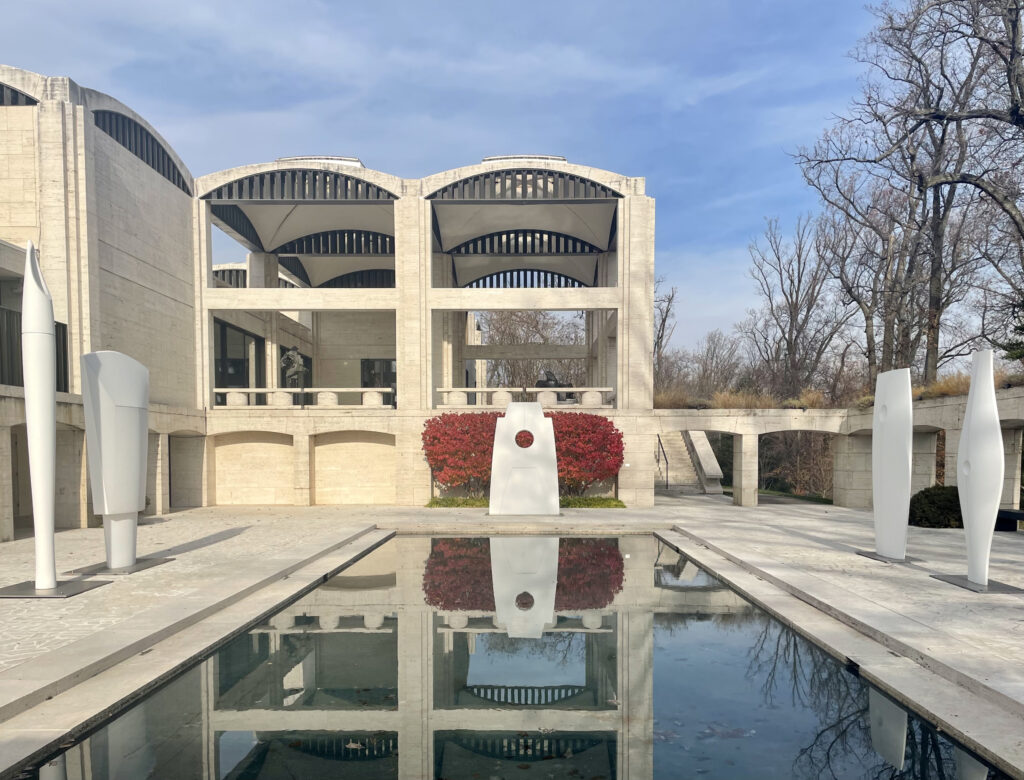Please join us in-person at The Kreeger Museum to celebrate our Emerging Professionals. Four speakers will be presenting on a wide range of topics.
Date: March 2, 2023
Location: The Kreeger Museum, 2401 Foxhall Rd NW, Washington, DC 20007
Transit: Tenleytown–AU on Red Line (2 mile walk)
D2, D6, and N4 bus lines (1 mile walk)
WCG Recommends Ridesharing – Limited Parking

Schedule:
Social hour: 5:00 – 6:00 pm
Lectures: 6:00 pm
◉ Emily Mercer – Graduate Fellow, SUNY Buffalo/Library of Congress
○ “A Moment of Reflection: ER-FTIR Analysis of the National Gallery of Art’s
Collection of Dorothea Lange Photographs”
◉ Katya Zinsli – Lunder Conservation Fellow, Smithsonian American Art Museum
○ “Assessing a Large Collection of Found Material: James Hampton’s “Throne of
the Third Heaven of the Nations Millennium General Assembly”
◉ Jones Kelly – Frame Conservation Technician, National Gallery of Art
○ “Case Study: Eva Hesse’s Test Piece for ‘Contingent’”
◉ Kate Brugioni Gabrielli – Conservator, former Engen Fellow, National Air & Space Museum
○ “Iron Stain Removal from White Paint Films”
See abstracts for these presentations BELOW.
Recordings of these talks are accessible HERE.
This event is free for WCG members, $10 for non-members.
The WCG encourages attendees to follow CDC guidelines; masks are always welcome and available.
Memberships are $35 for professionals and the 2022/2023 season is free for emerging professionals.
Join or renew at washingtonconservationguild.org/membership.
For more information about this meeting or WCG, please visit washingtonconservationguild.org.
Our meetings are public, and pictures may appear on WCG’s website and social media accounts.
Follow us on Twitter and Instagram and Facebook!
Abstracts
“A Moment of Reflection: ER-FTIR Analysis of the National Gallery of Art’s collection of Dorothea Lange Photographs” by Emily Mercer
Three months before Dorothea Lange’s passing in 1966, the Museum of Modern Art (MoMA) opened a retrospective of her life’s work, curated by John Szarkowski. Lange was very involved in the printing for MoMA’s 1966 exhibition, unlike when she worked for the Resettlement Administration and Farm Security Administration. The exhibition provided a unique opportunity for the world to view her work as she intended. In an interview, Irwin Welcher, Lange’s printer for the 1966 exhibition, reflected on his time spent with Lange. He recalled perfecting a coating formula for the photographs, noting the significance of this coating to Lange’s vision for her retrospective.
The National Gallery of Art’s collection includes many Lange photographs that were exhibited in the 1966 exhibition, and many that were not. External Reflectance-Fourier Transform Infrared spectroscopy (ER-FTIR) was performed on pairs of photographs of the same image, in which one print went on display at MoMA in 1966 and the other did not. Reference samples of modern photographic coatings were created to provide ER-FTIR spectra of known materials for comparison with the spectra from Lange’s prints. This presentation will discuss the identification of the coating used on the 1966 exhibition prints, which lead to a better understanding of Lange’s and Welcher’s working methods.
A recording of Mercer’s talk is available here.
“Assessing a Large Collection of Found Material: James Hampton’s ‘The Throne of the Third Heaven of the Nations Millennium General Assembly’ by Katya Zinsli
The Throne of the Third Heaven of the Nations Millennium General Assembly by James Hampton has a long history with many persisting mysteries. The Smithsonian American Art Museum has the privilege of stewarding this artwork, comprised of close to 200 components constructed of found materials like furniture and silver and gold-colored foils. Several campaigns of examination and treatment have been conducted on a portion of about 60 components of Hampton’s Throne, but the remaining components have never been fully documented, until this year with the start of a collaborative project between the museum’s conservation and registration departments that will examine, document, and research the remaining components over the next two years. This talk will cover the history of the Throne over the last 70 years and the ongoing approach to managing documentation and treatment of an artwork of this scale.
A recording of Zinsli’s talk is available here.
“Case Study: Eva Hesse’s Test Piece for ‘Contingent'” by Jones Kelly (They/them)
Modern artist Eve Hesse is well known for her use of experimentation with latex in the production of her most famous artworks, however this material created unique challenges for the conservation team at the National Gallery of Art. This presentation is an edited version of an ‘Art Talk’ I gave in the summer of 2022 where I presented my research on the conservation of Hesse’s work Test Piece for “Contingent.”
This talk was not recorded.
“Iron Stain Removal from White Paint Films” by Kate Brugioni Gabrielli (She/her)
Painted metal is ubiquitous on the composite aerospace objects in the collection of the National Air and Space Museum (NASM), Smithsonian Institution. Within this corpus conservators have found condition and aesthetic issues caused by ferrous staining on painted surfaces. This case study details the removal of disfiguring iron and organic staining from a white, alkyd paint film on a Korean-war-era missile.
As limited practical research is available on the chelation of iron stains from within painted surfaces, the authors of this study referenced existing procedures for chelating iron from marble, fabrics, ceramics, and archaeological wood. To better understand the treatment parameters, two experiments were carried out: The first aimed to replicate iron staining on alkyd-painted surfaces, and the second tested stain removal. Following trials with the test coupons, refinements to reagent concentration, pH, dwell time, and clearance procedures were made for the treatment of the object. These findings enhanced understanding and informed treatment of similar damages within the collection.
A recording of Gabrielli’s talk is available here.